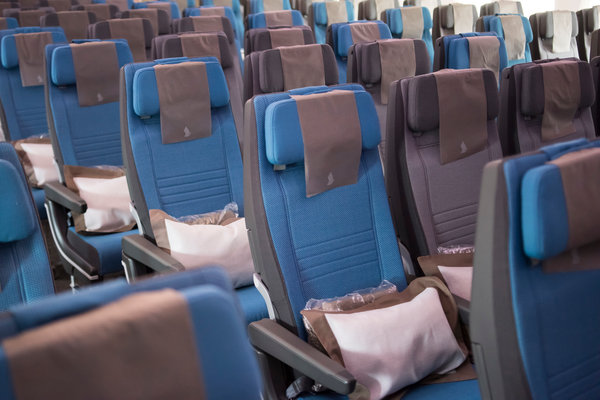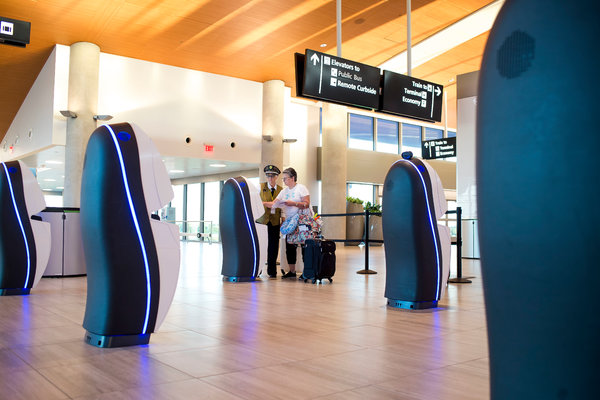For airlines, time on the ground is money. Financially speaking, planes only earn revenue for their companies when they are in the air, ferrying paying passengers. Which is one strong incentive to speed up boarding, deplaning and turnaround time.
That is why airlines continue to tinker with boarding procedures. United Airlines remodeled its boarding processes last fall to discourage passengers from lining up and clogging the boarding area. In January, Delta Air Lines expanded from having six numbered groups determine the order of boarding to eight color groups. Southwest Airlines is testing front- and rear-door boarding and deplaning at airports where the weather allows.
Boarding hierarchy didn’t matter much until about 10 years ago, when airlines began charging for checked bags. As the propensity to carry on luggage grew, so did the overhead bin wars. Early boarding, now aligned with frequent flier status and more expensive tickets, largely means avoiding them.
“Southwest maintains one reason it doesn’t assign seats is that it leads to faster boarding,” says Henry Harteveldt, a travel industry analyst and the founder of Atmosphere Research Group. “The problem is, at other airlines, you now have customers with frequent flier status who expect early boarding and have been educated for more than a decade that they’re special.”
That doesn’t stop airlines from toying with boarding plans and dangling line-jumping shortcuts, as the following chart on domestic boarding procedures suggests.
Alaska Airlines
Boarding by: Groups A through E. A and B have frequent flier status or premium class seats, C is in the back half of the main cabin, D is in the front and E is for “Saver” seats, which are the cheapest, largely nonrefundable and do not allow advance seat assignments.
What’s new: Alphabetical group boarding was adopted in 2018; Group E was added in early 2019 with the low-price fares.
Preboarding: Families with children under the age of 2, active duty military, first class.
How to line-jump: n/a, other than preboarding groups.
Carry-on policy: One personal item and one carry-on, measuring 22-by-14-by-9 inches maximum, are free. When overhead bin space runs out, bags checked at the gate are free.
American Airlines
Boarding Groups: Groups 1 through 9. Group 1 is first and/or business class and active-duty military; 2 through 4 reflect frequent flier status; 5 is for tickets purchased with extra legroom; 9 is for the lowest price “Basic Economy” where seats cannot be selected more than 48 hours in advance.
What’s new: Boarding was last updated in March 2017.
Preboarding: Members of the airline’s invitation-only ConciergeKey program. Families with children under the age of 2 may ask to preboard.
How to line-jump: Holders of most of the airline’s AAdvantage credit cards board with groups 4 and 5 (annual fee $99). Travelers may also buy priority boarding for $9 to $74 each way.
Carry-on policy: One personal item and one carry-on up to 22-by-14-by-9 inches free. When overhead bin space runs out, bags checked at the gate are free.
Delta Air Lines
Boarding Groups: Groups one through eight are classified by color on a spectrum running from purple, for the highest-status frequent flier members, to navy blue for Basic Economy, the lowest fare, which offers seat assignments only after check-in.
What’s new: The color system was adopted in January, expanding to eight boarding groups from six.
Preboarding: Customers needing extra time and active military members.
How to line-jump: Delta SkyMiles American Express credit card holders get priority boarding in the first Main Cabin group, or fifth group (annual fee $95).
Carry-on policy: One personal item and one carry-on up to 22-by-14-by-9 inches free. When overhead bin space runs out, bags checked at the gate are free.
Frontier Airlines
Boarding Groups: Zones 1 through 4. Zone 1 fliers have paid for a carry-on bag. Zones 2 through 4 go from the rear of the plane to the front.
What’s new: n/a
Preboarding: Anyone needing a wheelchair or other boarding assistance; unaccompanied minors.
How to line-jump: Flyers purchasing amenity bundles known as the Works or the Perks get priority boarding and free checked and carry-on bags. A passenger purchasing a carry-on bag gets Zone 1 boarding. Families with children under the age of 3 board after Zone 1 but before Zone 2. Holders of the Frontier Airlines World Mastercard get Zone 2 boarding (annual fee $79).
Carry-on policy: One personal item is free. Carry-on bags must be no larger than 24-by-16-by-10 inches and cost $35 at booking and run up to $60 at the gate.
JetBlue Airways
Boarding Groups: Groups A through E. A is for travelers purchasing an “Even More Space” seat; B through E groups stagger passengers seated throughout the plane to minimize congestion.
What’s new: In November, JetBlue introduced biometric self-boarding gates using facial recognition technology on international flights at New York’s Kennedy and Washington, D.C.’s Reagan airports.
Preboarding: Customers with disabilities; Mint (premium class); and Mosaic (high frequent flier status) fliers.
How to line-jump: To join Group A, purchase an “Even More Space” seat, which has extra legroom and varied prices but recently cost about $100 one way on a $300 round trip between New York and San Francisco. Passengers traveling with children in car seats and strollers and active military personnel board between Groups A and B.
Carry-on policy: One personal item and one carry-on up to 22-by-14-by-9 inches free.
Southwest Airlines
Boarding Groups: Open seating for Groups A through C, each with a boarding position numbered 1 through 60. Passengers line up by number (assigned, with some premium exceptions, by order of check-in) in their alphabetical group.
What’s new: At four airports in California — Burbank, Long Beach, Sacramento and San Jose — Southwest is experimenting with speeding up boarding and deplaning by simultaneously using front jet-bridge entries and rear doors that require the use of stairs.
Preboarding: Customers who have a specific seating need to accommodate their disability, or need assistance in boarding or stowing an assistive device.
How to line-jump: Business Select fares, which vary but can be double the lowest, nonrefundable fares, guarantee a boarding position between A1 and A15. Others can pay an extra $30 to $50 one way for a position from A1 to A15. Paying $15 to $25 one way for upgraded boarding 36 hours before the flight doesn’t guarantee A-list status, but will improve your boarding position. Children ages six or younger and a guardian may board before Group B.
Carry-on policy: One personal item and one carry-on up to 22-by-16-by-10 inches free.



Spirit Airlines
Boarding Groups: Zones 1 to 4. Zone 1 passengers have purchased carry-on bags; Zone 3 fliers are toward the back of the plane; Zone 4 fliers are toward the front of the plane.
What’s new: n/a
Preboarding: Passengers with disabilities and those traveling with children under the age of 2.
How to line-jump: Active military members board with Zone 2. Fliers can also purchase Shortcut Boarding for about $10 one way to get into Zone 2. Holders of the Spirit Airlines World Mastercard get Zone 2 boarding (annual fee $59).
Carry-on policy: Passengers are allowed only one personal item. Fees for full-size carry-on bags depend on the route, but recently ran $27 at the time of booking, and $65 at the gate for a flight from Chicago to Las Vegas.
United Airlines
Boarding Groups: Groups 1 through 5, that queue up through two boarding lanes. Group 1 through blue and all others through green.
What’s new: The airline changed its boarding in September 2018 to two boarding lanes from five to ease congestion at the gates and shifted group definitions to make them more balanced.
Preboarding: MileagePlus Premiere 1K customers, the highest frequent flier status; families traveling with children ages 2 and under; customers with disabilities; and active military members.
How to line-jump: United Explorer MileagePlus credit card holders board in Group 2 (annual fee $95).
Carry-on policy: One personal item and one carry-on up to 22-by-14-by-9 inches free for most fliers. When overhead bin space runs out, bags checked at the gate are free. Basic Economy fares are allowed a personal item but must pay to check a full-size carry-on.






